engine coolant AUDI A3 2012 Owner´s Manual
[x] Cancel search | Manufacturer: AUDI, Model Year: 2012, Model line: A3, Model: AUDI A3 2012Pages: 280, PDF Size: 70.11 MB
Page 196 of 280

194 Checking and filling
Checking and filling
Engine hood
Releasing the engine hood
The engine hood is released from inside the
vehicle .
Fig. 155 Driver' s side footwe ll: e ngin e hood release
lever
.. Open the driver's door.
.. Pull the release lever on the left under the
instrument panel
c> fig . 155 in direction of
the a rrow .
The hood pops up slight ly under spring pres
sure.
Opening the engine hood
Fig . 156 Engine hood releas e le ve r
Before opening the eng ine hood, make sure
that the windshie ld wipers are folded flat
against the windshield . Otherwise, they could
damage the paint on the hood.
.. Pull the release lever
r=;,fig . 156 in the direc
tion indicated by the arrow . This release the
hook under the hood .
.. Open the hood all the way.
A WARNING
-Hot engine coolant can burn you!
- To reduce the risk of being burned, never
open the hood if you see or hear steam
or coo lant escaping from the eng ine
compartment . Wait unt il no steam or
coolant can be seen or heard before care
fu lly opening the hood.
Closing the engine hood
.. Pull the hood down until the pressure from
the strut is reduced .
.. Let the hood
drop down and latch in p lace.
Do not try to push it shut; it may fail to en
gage
c> .&, .
A WARNING
--
A hood that is not completely latched
could fly up and b lock your view while dr iv
i ng.
- When you close the engine hood, check it
to make sure the safety catch has properly engaged . The hood shou ld be flush
with the surrounding vehicle body parts.
- If you notice while dr iv ing that the hood
is not secured properly, stop at once and
close it .
Working in the engine compartment
Be especially careful whenever you work in
the engine compartment!
Whene ve r you must pe rform any wo rk in the
eng ine compartment, for e xample chec king
and filling differ ent fluid s, the re i s a risk of
injury , burns and accident s. T o pr event p er
s onal injury alwa ys observe the foll owing
WARNING S. Th e engin e c ompartm ent of an y
v e hicl e is a hazardou s area!
r=;, .&.
A WARNING
To help avoid injury, before yo u check any
thing under the hood:
- Turn off the engine .
- Remove the ignition key.
Page 197 of 280
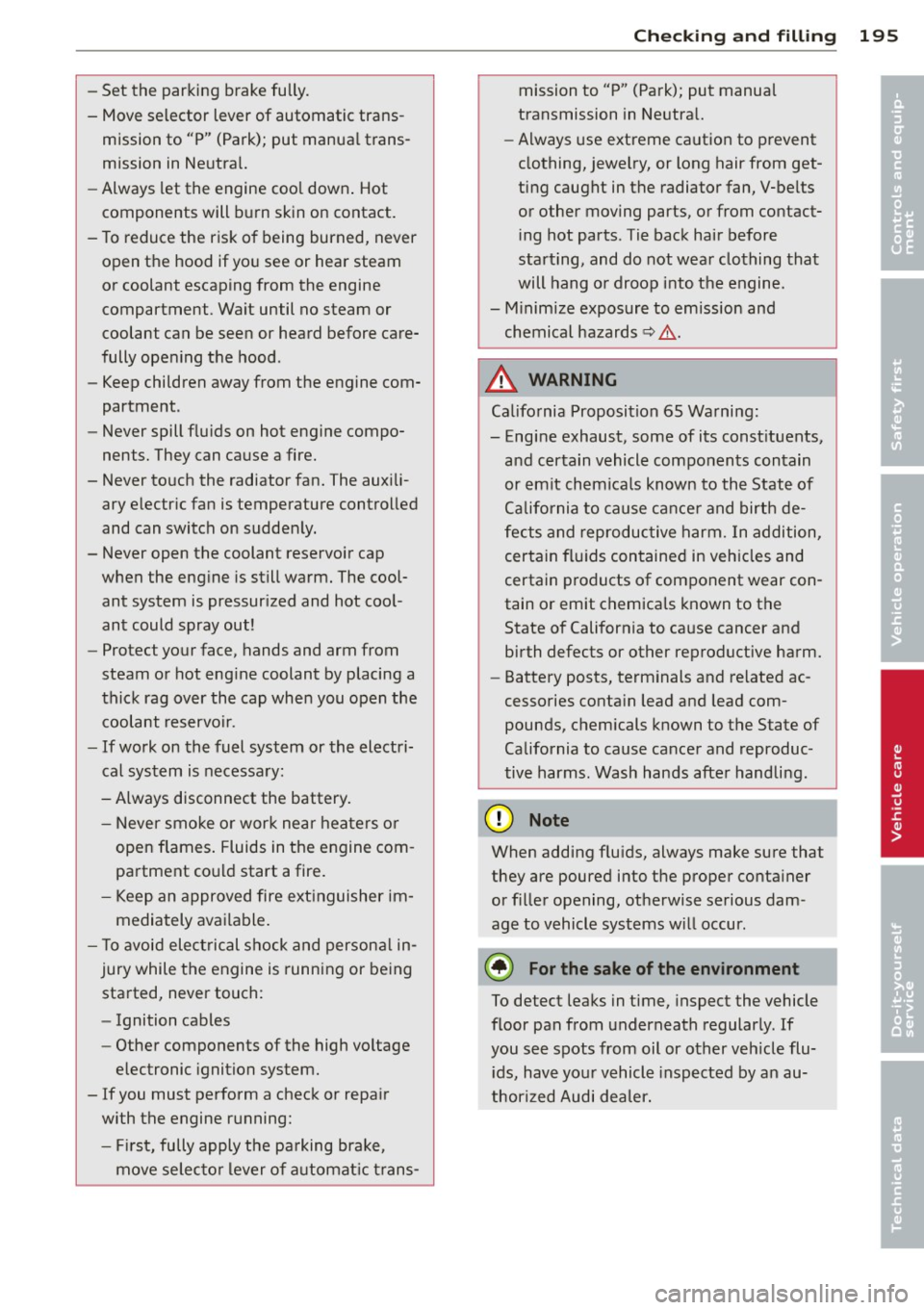
-Set the parking brake fully.
- Move selector lever of automatic trans-
mission to "P" (Park); put manual trans
mission in Neutral.
- Always let the engine cool down . Hot
components will burn skin on contact.
- To reduce the risk of being burned, never
open the hood if you see or hear steam
or coolant escaping from the engine
compartment . Wait until no steam or
coolant can be seen or heard before care
fully opening the hood .
- Keep children away from the engine com
partment .
- Never spill fluids on hot engine compo
nents. They can cause a fire.
- Never touch the radiator fan. The auxili
ary electric fan is temperature controlled
and can switch on suddenly.
- Never open the coolant reservoir cap
when the engine is still warm. The cool
ant system is pressurized and hot cool ant could spray out!
- Protect your face, hands and arm from
steam or hot engine coolant by placing a
thick rag over the cap when you open the
coolant reservoir .
- If work on the fuel system or the electri
cal system is necessary:
-Always disconnect the battery.
- Never smoke or work near heaters or
open flames. Fluids in the engine com
partment could start a fire.
- Keep an approved fire extinguisher im
mediately available.
- To avoid electrical shock and personal in
jury while the engine is running or being
started, never touch:
- Ignition cables
- Other components of the high voltage
electronic ignition system.
- If you must perform a check or repair
with the engine running:
- First, fully apply the parking brake,
move selector lever of automatic trans-
Checking and filling 195
mission to "P" (Park); put manual
transmission in Neutral.
- Always use extreme caution to prevent
clothing, jewelry, or long hair from get
ting caught in the radiator fan, V-belts
or other moving parts, or from contact
ing hot parts . Tie back hair before
starting, and do not wear clothing that
will hang or droop into the engine .
- Minimize exposure to emission and
chemical hazards~&. .
A WARNING
California Proposition 65 Warning:
- Engine exhaust, some of its constituents,
and certain vehicle components contain
or emit chemicals known to the State of
California to cause cancer and birth de
fects and reproductive harm. In addition,
certain fluids contained in vehicles and
certain products of component wear con
tain or emit chemicals known to the State of California to cause cancer and
birth defects or other reproductive harm.
- Battery posts, terminals and related ac
cessories contain lead and lead com
pounds, chemicals known to the State of
California to cause cancer and reproduc
tive harms. Wash hands after handling.
Q) Note
When adding fluids, always make sure that
they are poured into the proper container
or filler opening, otherwise serious dam
age to vehicle systems will occur .
@ For the sake of the environment
To detect leaks in time, inspect the vehicle
floor pan from underneath regularly . If
you see spots from oil or other vehicle flu ids, have your vehicle inspected by an au
thorized Audi dealer. •
•
Page 198 of 280
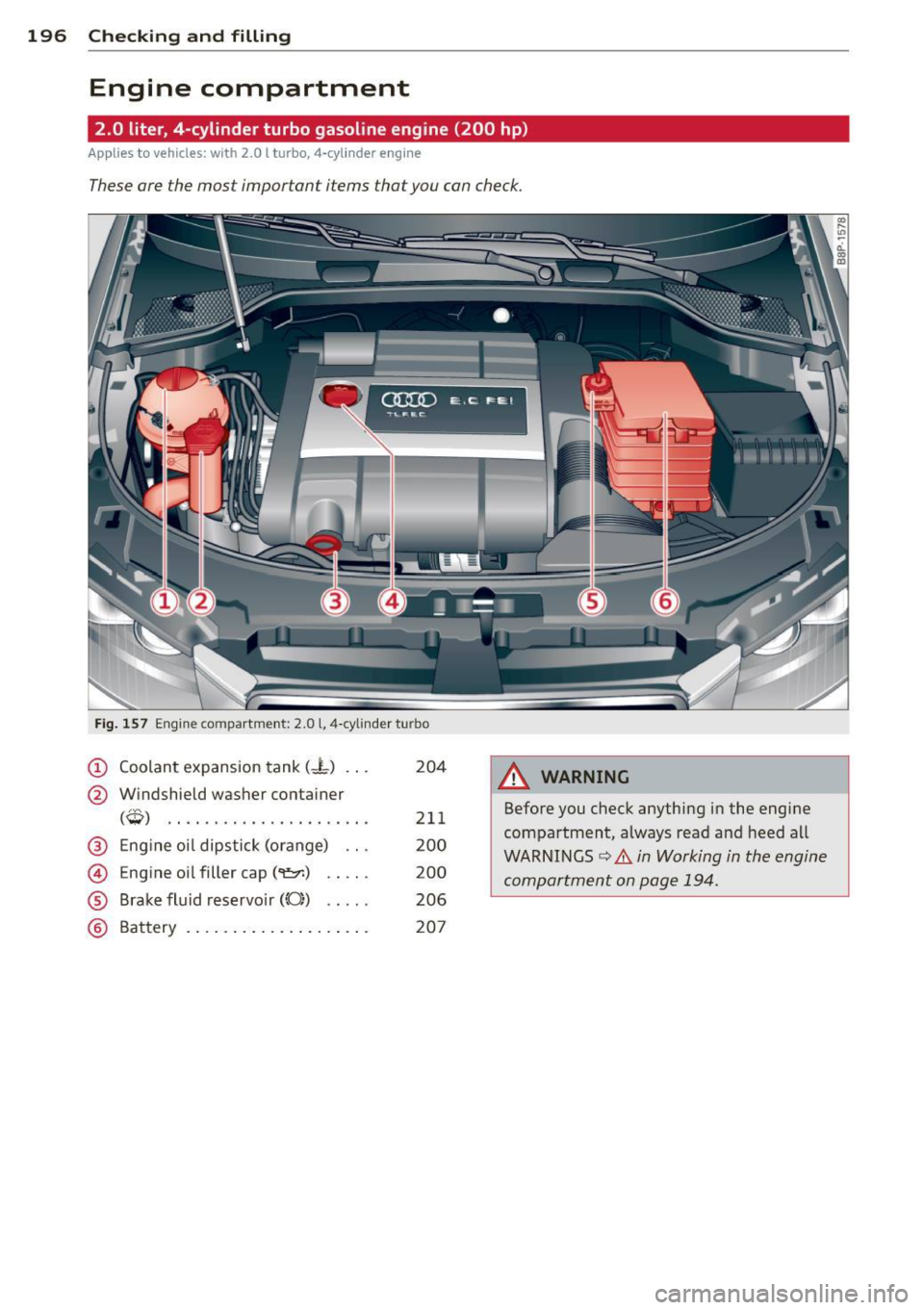
196 Checking and filling
Engine compartment
2.0 liter 4-c tinder turbo gasoline engine (200 hp)
Applies to vehicles: with 2.0 l turbo, 4-cylinder engine
These are the most important items that you can check.
(]JD[) £. C. l"E. t .,.."-.., &t".
~ ------
fig. 157 Engine compartment: 2.0 L, 4-cylinder tu rbo
(!) Coolant expansion tank (- L) .. .
@ Windshield washer conta iner
( ffi
) ,... ...... ........... .... .
® Eng ine oi l dipstick (orange) .. .
@ Engine oil filler cap ('1:::r.) .. .. .
® Brake fluid reservo ir ((0)) .... .
@ Battery .. ..... ..... .... .. . .
204
211
200
200
206
207
A WARNING
-Before you check anything in the engine
compartment, always read and heed a ll
WARNINGS c:> &. in Working in the engine
compartment on page 194.
-
Page 199 of 280
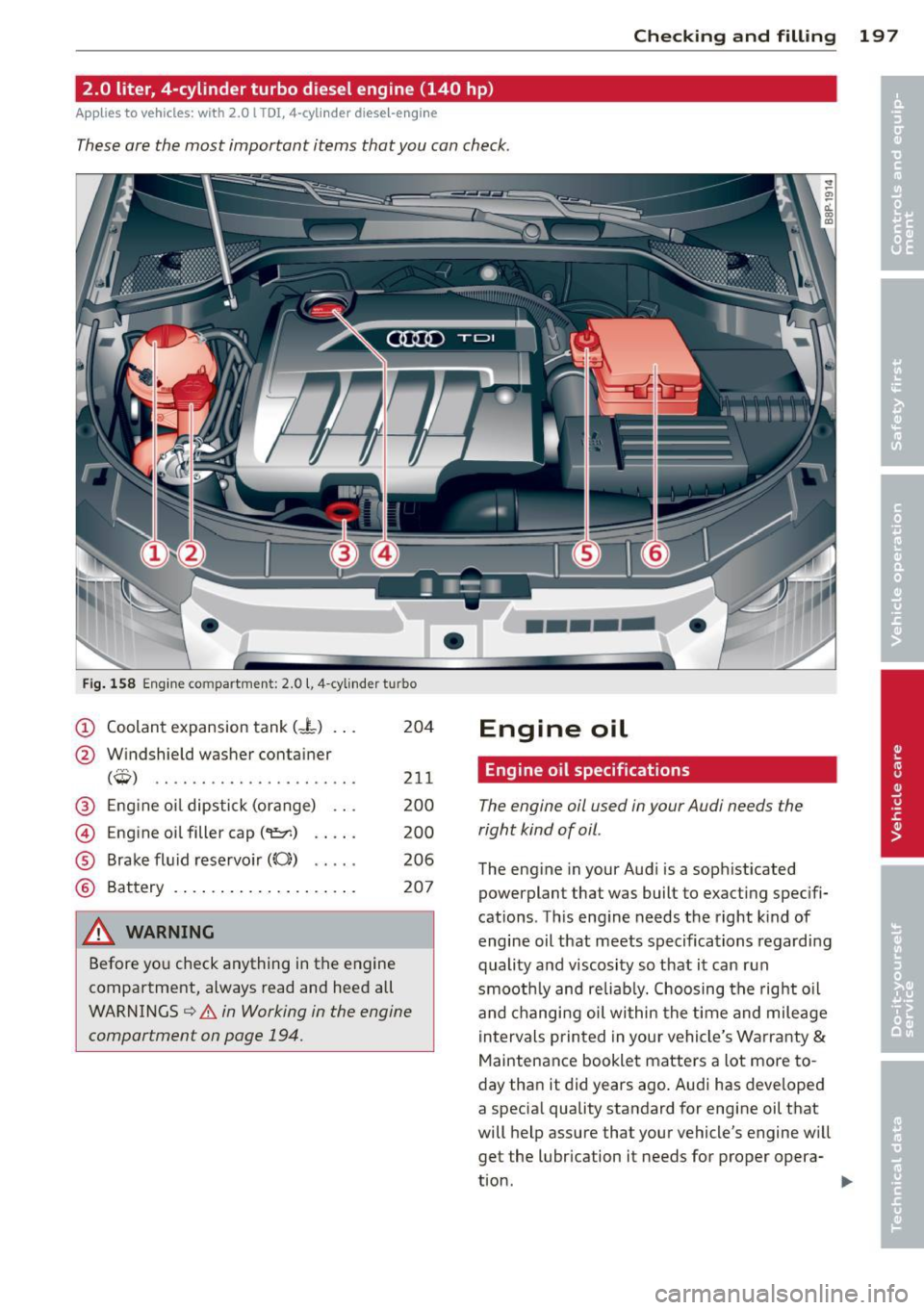
Checking and fillin g 197
2.0 liter, 4-cylinder turbo diesel engine (140 hp)
Applies to vehicles: with 2.0 l TOI, 4-cylinder diese l-engin e
These are the most important items that you can check .
Fig. 158 Engine compartment: 2.0 l, 4-cylinder tu rbo
(D Coolant expansion tank ( ... t) .. .
@ Windshield washer container 204
Cw)
.............. ...... . . 211
@ E ng ine oi l dipstick (orange) . . . 200
@ Engine oil filler cap ("t!::r.) . . . . . 200
® Brake fluid reservo ir ((0)) . . . . . 206
® Battery . . . . . . . . . . . . . . . . . . . . 207
A WARNING
Before yo u check anything in the engine
compartment, always read and heed all
WARNINGS ¢&. in Working in the engine
compartment on page 194.
-
Engine oil
Engine oil specifications
The engine oil used in your Audi needs the
right kind of oil.
The engine in your Audi is a sophisticated powerplant that was built to exacting specifi
cations . Th is eng ine needs the right kind of
engine oil that meets specifications regarding
quality and viscosity so that it can run
smoot hly and reliab ly. Choosing the right o il
and changi ng oil within the t ime and mileage
intervals printed in you r vehicle's Warranty
&
Maintenance booklet matters a lot more to
day than it did years ago . Audi has developed
a specia l quality standard for engine oil that
will help assure that your vehicle's engine w ill
get the lubr ication it needs for proper opera
tion.
Page 205 of 280
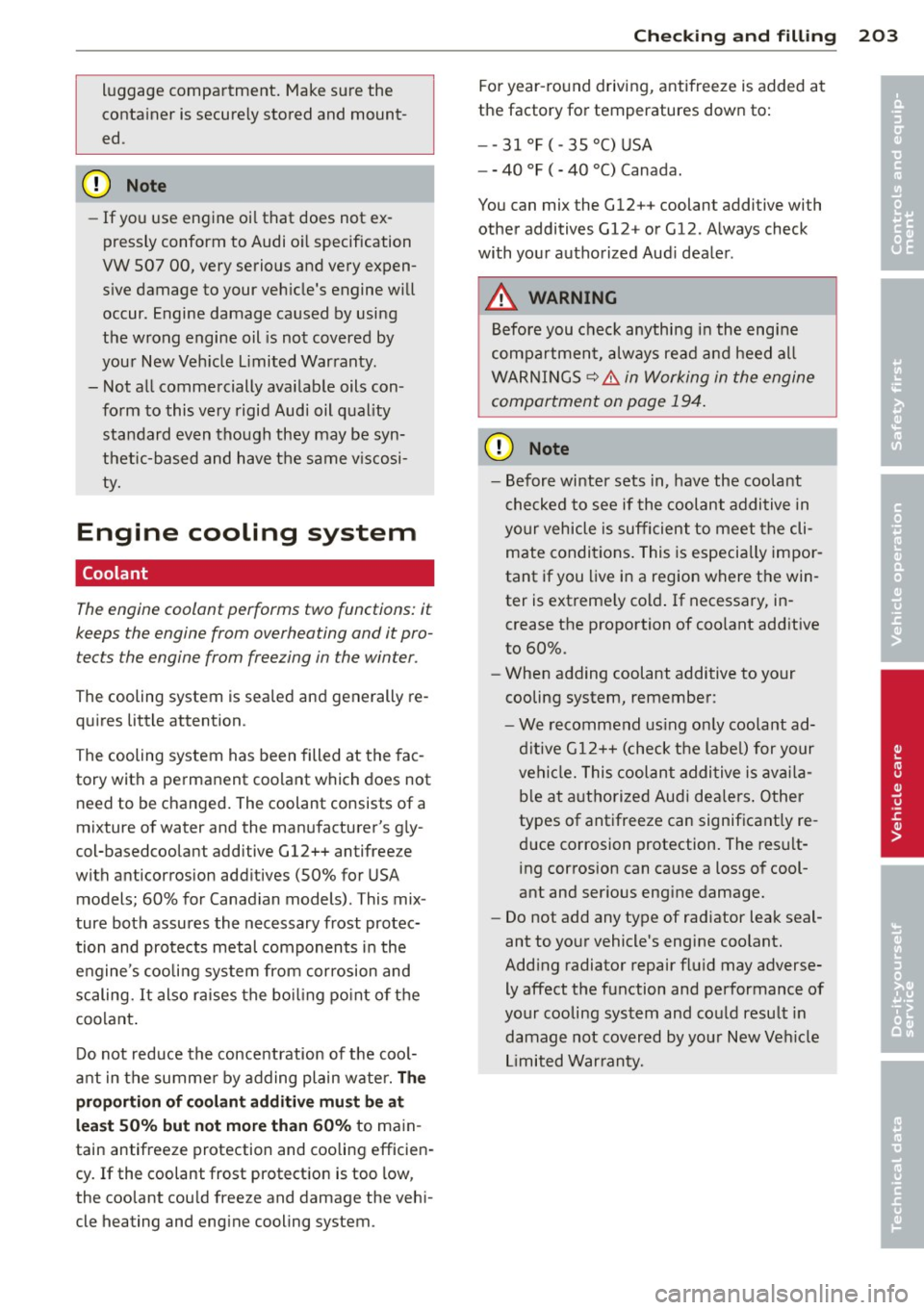
luggage compartment. Make sure the
container is securely stored and mount
ed.
0 Note
-If you use engine oil that does not ex
pressly conform to Audi oil specification
VW 507 00, very serious and very expen
sive damage to your vehicle 's engine will
occur . Engine damage caused by using
the wrong engine oil is not covered by
your New Vehicle limited Warranty .
- Not all commercially available oils con
form to this very rigid Audi oil quality
standard even though they may be syn
thetic-based and have the same viscosi
ty.
Engine cooling system
Coolant
T he engine coolant performs two functions: it
keeps the engine from overheating and it pro
tects the engine from freezing in the winter.
The cooling system is sealed and generally re
quires little attention.
The cooling system has been filled at the fac
tory with a permanent coolant which does not need to be changed. The coolant consists of a
mixture of water and the manufacturer's gly
col-based coolant additive Gl2++ antifree ze
with anticorrosion additives (50% for USA models; 60% for Canadian models). This mix
ture both assures the necessary frost protec
tion and protects metal components in the
engine 's cooling system from corrosion and
scaling.
It also raises the boiling point of the
coolant.
Do not reduce the concentration of the cool
ant in the summer by adding plain water.
The
proportion of coolant additive must be at
least 50% but not more than 60%
to main
tain antifreeze protection and cooling efficien
cy. If the coolant frost protection is too low,
the coolant could freeze and damage the vehi
cle heating and engine cooling system.
Checking and filling 203
For year-round driving, antifreeze is added at
the factory for temperatures down to:
--31°F(-35°C)USA
- - 40 °F ( - 40 °C) Canada.
You can mix the Gl2 ++ coolan t additive with
other additives Gl2 + or Gl2. Always check
with your authorized Audi dealer .
A WARNING
-
Before you check anything in the engine
compartment, always read and heed all
WARNINGS~
& in Working in the engine
comportment on page 194.
(D Note
- Before winter sets in, have the coolant
checked to see if the coolant additive in
your vehicle is sufficient to meet the cli
mate conditions. This is especially impor
tant if you live in a region where the
win
ter is extremely cold. If necessary, in
crease the proportion of coolant additive
to 60% .
- When adding coolant additive to your
cooling system, remember :
- We recommend using only coolant ad
ditive G 12++ (check the label) for your
vehicle. This coolant additive is availa
ble at authorized Audi dealers. Other
types of antifreeze can significantly re
duce corrosion protection. The result
ing corrosion can cause a loss of cool
ant and serious engine damage.
- Do not add any type of radiator leak seal
ant to your vehicle's engine coolant.
Adding radiator repair fluid may adverse ly affect the function and performance of
your cooling system and could result in
damage not covered by your New Vehicle
Limited Warranty.
•
•
Page 206 of 280
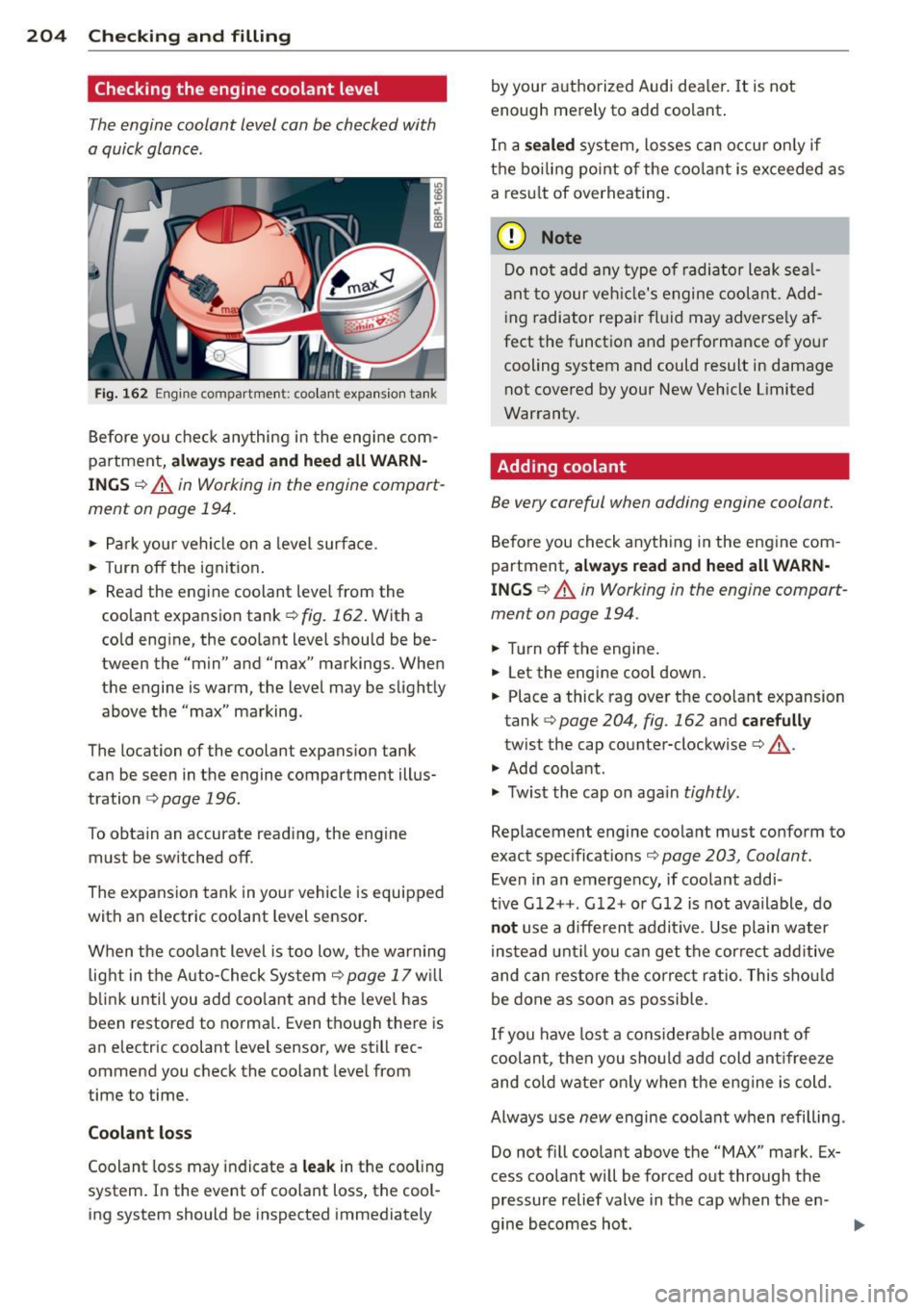
204 Checking and filling
Checking the engine coolant level
The engine coolant level can be checked with
a quick glance .
Fig. 162 Engine compartme nt: coo lant expansio n tank
Before you check anything i n the eng ine com
partment,
a lw ays rea d and h eed all WARN
ING S ¢&. in Working in the engine compart
ment on page 194.
.. Park your vehicle on a level surface.
.. Turn
off the ignit ion .
.. Read the eng ine coolant leve l from the
coolant expansion tank<=>
fig. 162 . With a
cold eng ine, the coo lant level should be be
tween the "min" and "max" markings . When
the engine is warm, the level may be slightly above the "max" marking.
The location of the coolant expansion tank
can be seen in the engine compartment illus
tration
i:> page 196.
To obtain an accurate read ing, the engine
must be switched
off.
The expansion tank in yo ur vehicle is equipped
with an e lectric coolant level sensor .
When the coolant level is too low, the warning light in the Auto -Check System
c> page 17 w ill
blink until you add coo lant and the level has
been restored to norma l. Even though there is
an electric coolant level sensor, we still rec
ommend you check the coolant level from
time to time.
Coolant lo ss
Coolant loss may indicate a le ak in the cooling
system . In the event of coolant loss, the cool
ing system should be inspected immediately by your authorized Audi dea
ler .
It is not
enough merely to add coolant .
In a
se aled system, losses can occur on ly if
the boiling point of the coo lant is exceeded as
a res ult of overheating.
(D Note
Do not ad d any type of radiator leak sea l
ant to your veh icle's engine coolant . Add
i ng radiator repair fl uid may adverse ly af
fect the funct ion and performance of your
cooling system and could result in damage not covered by your New Veh icle Limited
Warranty .
Adding coolant
Be very careful when adding engine coolant.
Before you check anything in the eng ine com
partment,
a lw ays re a d and heed all WARN
INGS c::> A in Working in the engine compart
ment on page 194 .
.. Turn off the engine .
.. Let the engine cool down.
.. Place a thick rag over the coolant expansion
tank
c::> page 204, fig . 162 and ca refull y
twist the cap counter-clockwise c::> A.
.. Add coo lant .
.. Twist the cap on aga in
tightly .
Replacement engine coolant must conform to
exact spec ificat ions
c::> page 203, Coolant.
Even in an emergency, if coolant addi-
t ive G12++ . G 12+ or G12 is not ava ilable, do
n ot use a d iffe rent addit ive. Use plain water
instead unt il you can get the correct add itive
and can restore the correct ratio. This shou ld
be done as soon as possible .
If you have lost a considerab le amou nt of
c oolant, then you sho uld add cold ant ifree ze
and co ld wate r on ly when the engine is cold.
Always use
new engine coo lant when refilling .
Do not f ill coolant above the
"MAX" mark. Ex
cess coolant will be forced out through the
pressure relief valve in the cap when the en -
gine becomes hot .
Iii>
Page 207 of 280
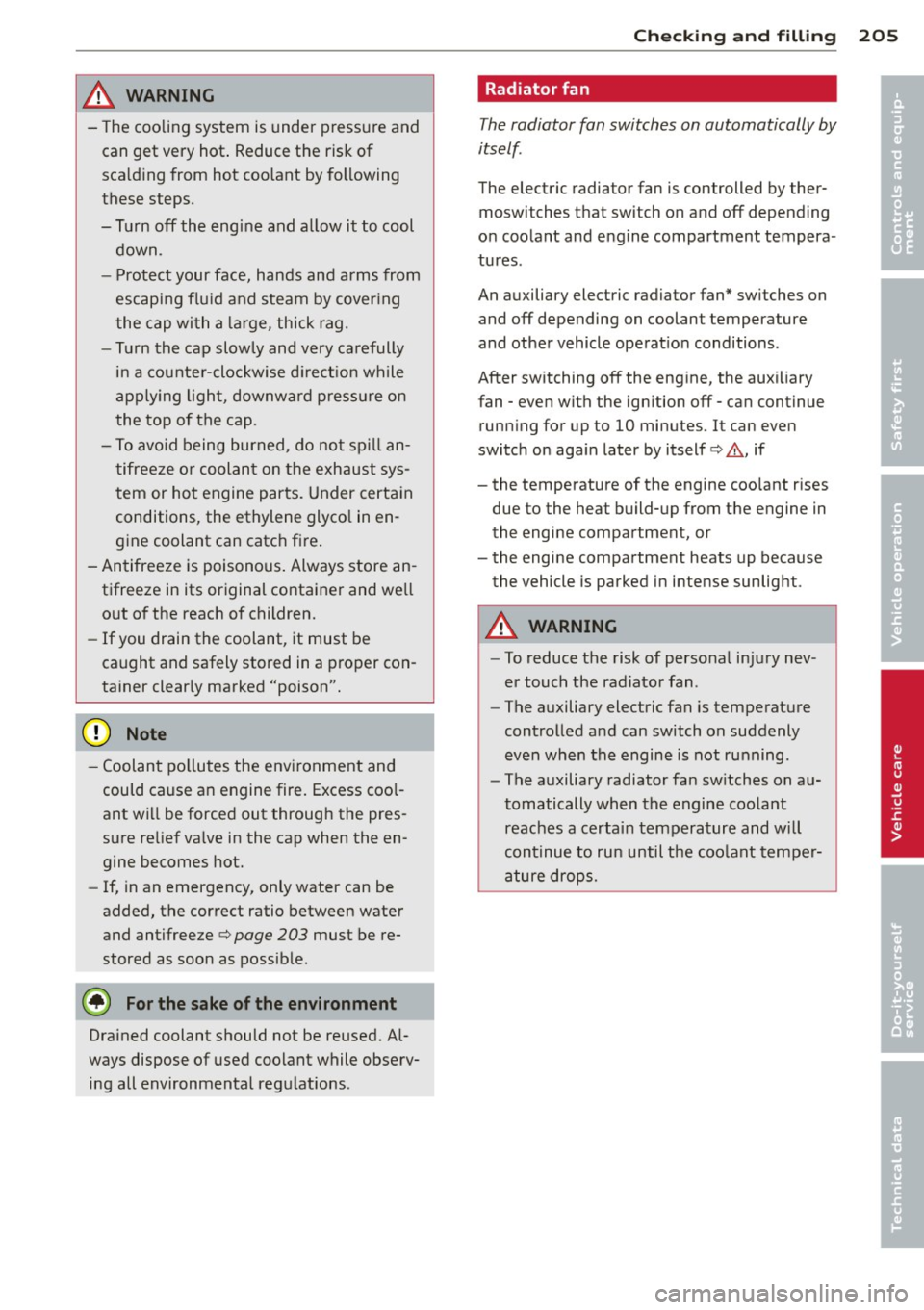
& WARNING
-The cooling system is under p ress ure and
can get very hot . Reduce the risk of
sca ld ing from hot coo lant by following
these steps.
- Tur n off the engine and a llow it to cool
down.
- Protect your face, hands and arms from
escap ing flu id and steam by cover ing
the cap wi th a large, thick rag.
- Tu rn the cap slowly and very ca refully
i n a cou nte r-clockw ise d irect ion w hile
ap ply ing ligh t, downw ard press ure on
the top of the cap.
- To avo id being burned, do no t sp ill an
tifreeze o r coolan t on the exhaust sys
tem or hot engine parts. Under certa in
conditions, the ethylene glyco l in en
gine coolant can catc h fir e.
- An tifreeze is poisonous . Always store an
tifreeze in its or iginal co ntainer and we ll
o ut o f the reach of children.
- If you drain the coolant, it must be
caught and safely stored in a p roper con
tainer clearly marked "poison".
(D Note
- Coolant po llutes the env ironment and
could cause an engine fire. Excess coo l
ant wi ll be forced out throug h the pres
su re re lief va lve in the cap when the en
gine becomes hot.
- If, in an emergency, only water can be
added, the cor rect ratio between water
and antifreeze
c:> page 203 must be re
stored as soon as possib le.
@) For the sake of the environment
Drained coolant shou ld n ot be re used. Al
ways dispose of used coolant while obse rv
ing all environmental regulations.
Checkin g and fillin g 205
Radiator fan
The radiator fan switches on automatically by
itself .
The electric radiator fan is controlled by ther
moswitches t hat sw itch on a nd off depending
o n coo lant and eng ine compartment tempera
tures .
An a uxiliary electric radiator fan* sw itches on
and off depending on coolant temperature
and othe r vehicle operat io n conditions.
After switching off the eng ine, the auxiliary
fan -even with the ignition off -can continue
runn ing for up to 10 minutes. It ca n even
switch on aga in later by itself
c:> A , if
- the temperature of the engine coo lant rises
due to the heat build-up from the engine in
the engi ne compartment , or
- the engine compa rtment heats up because
the vehicle is parked in intense sunlig ht.
& WARNING
- To reduce the risk of personal in ju ry nev
er touch the radiator fan .
- The auxiliary electric fan is temperature
contro lled a nd can switch on suddenly
even when the engine is not ru nning.
- The a uxiliary radiator fa n sw itches on a u
tomatically when the engine coo lant
reaches a certa in te mpera tu re and w ill
con tinue to ru n until t he coo lant temper
a ture drop s.
•
•
Page 213 of 280
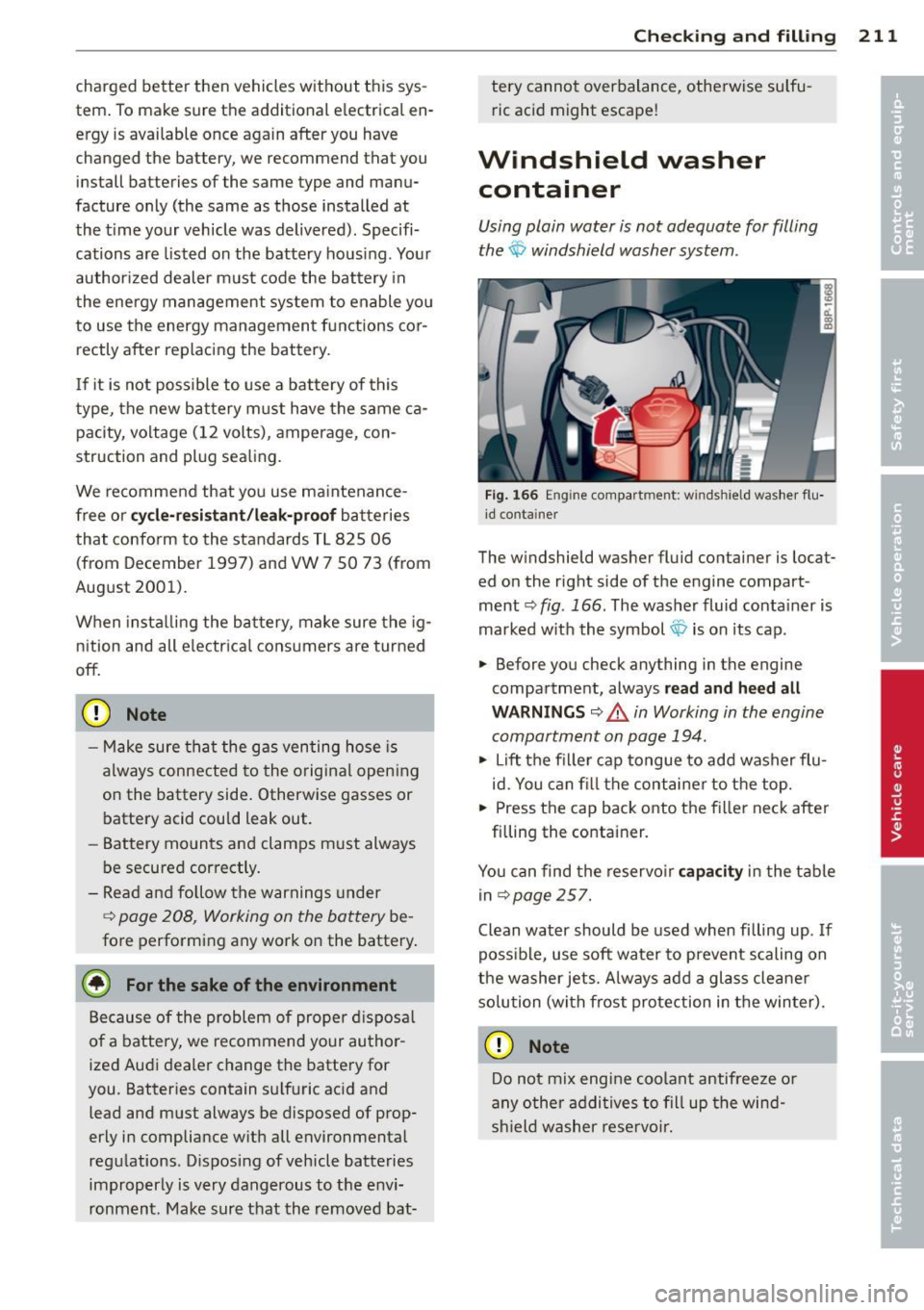
charged better then vehicles without this sys
tem . To make sure the additional e lectrica l en
ergy is available once again after you have
changed the battery, we recommend that you install batteries of the same type and manu
facture only (the same as those installed at
the t ime your vehicle was delivered). Specifi
cations are listed on the battery hous ing . Your
authorized dealer must code the battery in
the energy management system to enable yo u
to use the energy management functions cor
rectly after replacing the bat tery.
If it is not possible to use a battery of this
type, the new battery must have the same ca
pacity, voltage (12 volts) , amperage, con
struction and plug sealing.
We re commend that you use ma intenance
free or
cy cle -re sis tant /le ak-proof batteries
that conform to the standards TL
825 06
(from December 1997) and VW 7 SO 73 (from
Aug ust 2001).
When insta lling the bat tery , make sure the ig
n ition and all e lectrica l consumers are turned
off .
CD Note
-Make sure tha t the gas venting hose is
always connected to the o riginal open ing
on the battery side . Otherwise gasses or
battery acid could leak out.
- Battery mounts and clamps m ust always
be secured correctly.
- Read and follow the warnings under
C? page 208, Working on the battery be
fore performing any work on the battery .
@ For the sake of the environment
Because of the problem of proper d isposa l
o f a battery, we recommend your author
ized Audi dealer change the batte ry for
you. Batteries contain su lfuric ac id and
lead and must always be disposed of prop
erly in compliance w ith all environmental
regu lations . D isposing of vehicle batte ries
improperly is very dangerous to the envi
ronment. Make sure that the removed bat-
Checkin g and fillin g 211
tery cannot overbalance, otherwise su lfu
ric acid might escape!
Windshield washer container
Using plain water is not adequate for filling
the $ windshield washer system .
Fig. 166 En gin e compart men t: w in ds hield washer flu
i d co ntai ner
The windshield washer fluid container is locat
ed on the right side of the engine compart
ment ~
fig. 166. The washer fluid conta iner is
marked w ith the symbol $ is on its cap .
.,. Before you check anything in the engine
compartment, always
read and heed all
W ARNINGS ~ _&. in Working in the engine
compartment on page 194.
.,. Lift the fil le r ca p tongue to add washer flu
id. You can fi ll the container to the top.
.,. Press the cap back onto the f iller neck after
f illing the container .
You can find the reservo ir
capacity in t he t able
in
C? page 257.
Clean water should be used when filling up . If
poss ible, use soft water to prevent scaling on
the washer jets. Always add a glass cleane r
solu tion (with frost protection in t he win ter).
CD Note
Do not mix engi ne coolant antifreeze o r
a ny o ther addi tives to fill up the wind
sh ield washer rese rvoi r.
Page 263 of 280
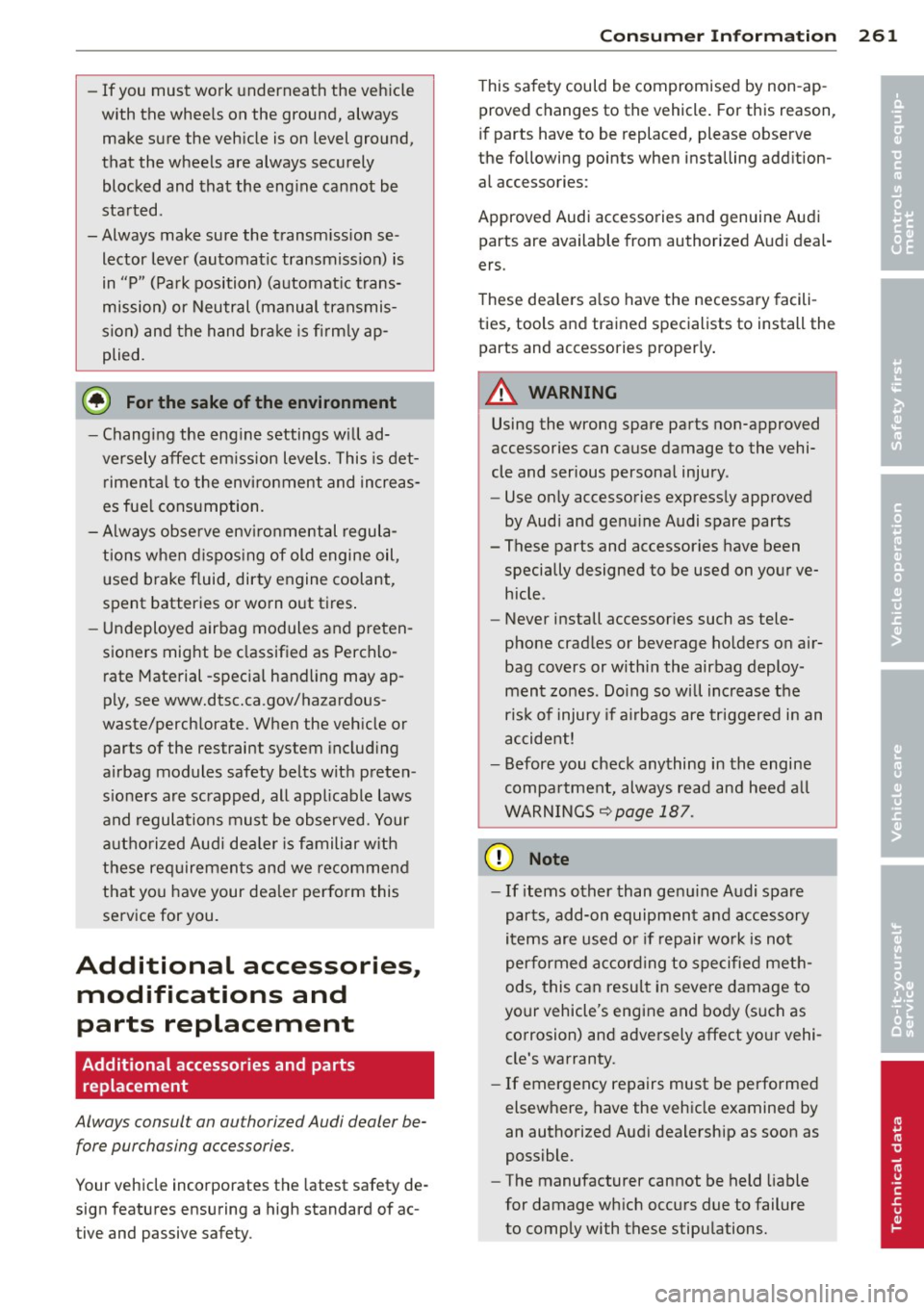
-If you must work underneath the vehicle
with the whee ls on the ground, always
make sure the vehicle is on level ground,
that the wheels are always secu rely
blocked and tha t the eng ine cannot be
started.
- Always make sure the transm ission se
lector lever (automatic transmiss ion) is
in "P" (Pa rk position) (a utomat ic trans
mission) or Neutral (manual transmis
sion) and the hand brake is fi rm ly ap
plied.
@, For the sake of the environment
- Changing the eng ine settings w ill ad
versely affect em ission levels. This is det
rimental to the environment and increas
es fue l cons umption.
- Always obse rve env ironmental regula
tions when d ispos ing of old engine oil,
used b rake fluid, dirty engine coolant,
spent batteries or worn out tires .
- Undeployed airbag modules and preten
s ioners might be classified as Perchlo
rate Mate rial -special handling may ap
ply, see www.dtsc.ca.gov/hazardous
waste/perchlorate. When the veh icle or
parts of the restraint system includ ing
airbag modules safety belts with preten
s ioners are scrapped, all appl icable laws
and regulations must be observed. Your
autho rized Audi dea le r i s familiar w ith
these req uirements and we recommend
that yo u have your dea le r perform this
service for you.
Additional accessories, modifications and
parts replacement
Additional accessories and parts
replacement
Always consult an authorized Audi dealer be
fore purchasing accessories .
Your vehicle incorporates the latest safety de
sign features ensuring a high standard of ac
tive and passive safety .
Consumer In formation 26 1
This safety could be compromised by non-ap
proved changes to the vehicle . For this reason,
if parts have to be replaced, please observe
the following points when installing add ition
al accessories:
Approved Audi accessories and genuine Audi parts are available from authorized Audi deal
ers.
T hese dea lers a lso have the necessary facili
ties, tools and trained specialists to install the parts and accessories properly .
_& WARNING
Using the wrong spare parts non-approved
accessories can cause damage to the vehi
cle and serious personal injury.
- Use on ly accessories expressly approved
by Audi and genu ine Audi spare parts
- These parts and accessories have been
specially designed to be used on your ve
hicle.
- Never install accessor ies such as tele
phone cradles or beverage ho lders on air
bag covers or within the airbag deploy
ment zones. Do ing so will increase the
ris k of injury if a irbags are triggered in an
accident!
- Before you check anything in the engine
compa rtment, always read and heed a ll
WARNINGS
<:!)page 187.
(D Note
-If items other than genu ine Audi spare
parts, add-on equipment and accessory
items are used o r if repair wo rk is not
performed accord ing to specified meth
ods, this can resu lt in severe damage to
your vehicle's engine and body (such as
corrosion) and adve rsely affect yo ur vehi
cle 's warranty.
- If emergency repairs must be performed
elsewhere, have the vehicle examined by
an authorized Audi dealership as soon as
possible.
- The manufacturer cannot be held liable
for damage wh ich occ urs due to failure
to comply with these stipulations.
•
•
Page 266 of 280
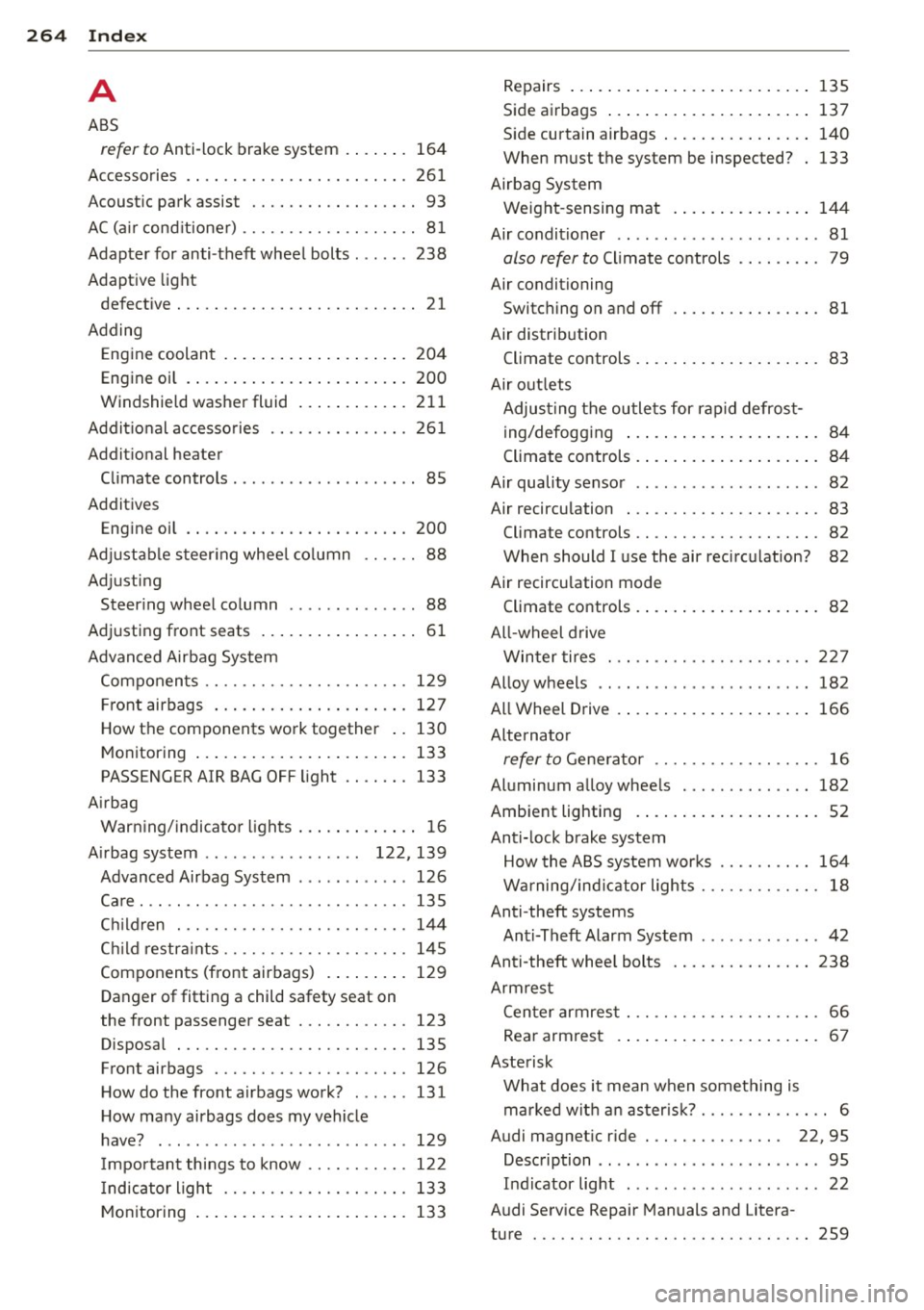
264 Index .:..:..:..::....::..
...:..._ ___________________________ _
A
ABS
refer to Anti-lock brake system . ... .. . 164
Accessories .. ... .. ..... ... .. .. .. .. . 26 1
Acoust ic park assist ........ .. .. .... .. 93
AC (a ir cond itioner) ......... .. .. .. .. .. 81
Adapter for anti-theft wheel bolts . .. .. . 238
Adaptive light
defective . . . . . . . . . . . . . . . . . . . . . . . . . . 21
Adding Engine coolant .......... .... ..... . 204
Engine oil . ...... ....... ... .. .... . 200
Windshield washer fluid ............ 211
Addit ional accessories .......... .... . 261
Additional heater Climate controls . . . . . . . . . . . . . . . . . . . . 85
Additives Engine oil . ............... ... .. .. . 200
Adj ustab le steering wheel column .... .. 88
Adjusting Steer ing wheel column ........ .. .... 88
Adjusting front seats ........ ... .... .. 61
Advanced Airbag System
Components ... .......... .. .. .. .. . 129
Fr ont airbags ................ .... . 127
How the components work together .. 130
Monitoring ................. ..... . 133
PASS ENG ER A IR BAG OFF light .. .... . 133
A irbag
Warning/indicator lights ............. 16
A irbag system . . . . . . . . . . . . . . . . . 122, 139
Advanced Airbag System . . . . . . . . . . . . 126
Care . .. .. ............... .. .. .... . 135
Ch ildren . .... ........... .. .. .. .. . 144
Ch ild r estra ints ........... .. .. .. .. . 145
Components (front airbags) . ... .... . 129
Danger of fitting a child safety seat on
the front passenger seat . . . . . . . . . . . . 123
Disposal . ................. .. .... . 135
Front airbags . ........... .. .. .... . 126
How do the front airbags work? . . . . . . 131
H ow many airbags does my vehicle
have? ..... .......... ...... ... .. . 129
I mportant things to know .... .. .... . 122
I ndicator light ........... .. .. .. .. . 133
Monitoring ................. ..... . 133 Repairs ...
.... .. ............. .... 135
Side airbags ..... ................ . 137
S ide curtain airbags ................ 140
When must the system be inspected? 133
Airbag System
Weight-sensing mat .............. . 144
Air conditioner .. .. ................ .. 81
also refer to Climate controls .. .. .. .. . 79
Air conditioning Switching on and off ........... .. .. . 81
Air distribution Climate controls . ................. .. 83
Air outlets Adjusting the outlets for rapid defrost -
ing/defogging ... ................ .. 84
Climate controls . .............. ..... 84
Air quality sensor . . . . . . . . . . . . . . . . . . . . 82
Air recirculation . .. ... .......... .... . 83
Climate controls .. ............. .... . 82
When should I use the air recirculation? 82
Air recirculation mode Climate controls . ................. .. 82
All-wheel drive Winter tires ... .. ... .......... .... 227
Alloy wheels ...... ................ . 182
All Wheel Drive .... ............. .... 166
Alternator
refer to Generator ............. .. .. . 16
Aluminum alloy wheels .... ...... .... 182
Ambient lighting . . . . . . . . . . . . . . . . . . . . 52
Anti-lock brake system How the ABS system works ........ .. 164
Warning/ind icator lights ........ .. .. . 18
Anti -theft systems
Anti-Theft Alarm System . . . . . . . . . . . . . 42
Anti-theft wheel bolts ........... .... 238
Armrest Center armrest . . . . . . . . . . . . . . . . . . . . . 66
Rear armrest .... ................ .. 67
Asterisk What does it mean when something is
marked with an aster isk? ........ .... .. 6
Audi magnetic ride . . . . . . . . . . . . . . . 22, 9S
Description . . . . . . . . . . . . . . . . . . . . . . . . 95
Indicator light ... ....... ...... .. .. . 22
Audi Service Repair Manuals and Litera-
ture 259